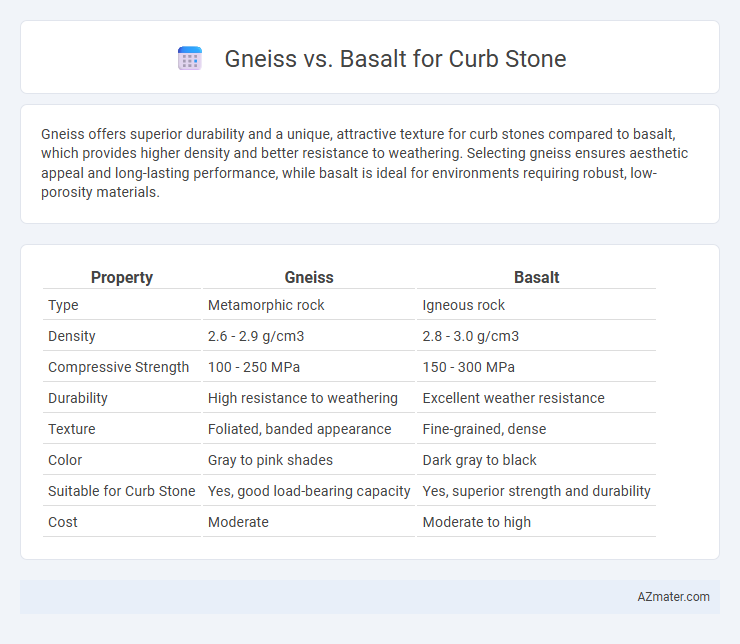Gneiss offers superior durability and a unique, attractive texture for curb stones compared to basalt, which provides higher density and better resistance to weathering. Selecting gneiss ensures aesthetic appeal and long-lasting performance, while basalt is ideal for environments requiring robust, low-porosity materials.
Table of Comparison
| Property | Gneiss | Basalt |
|---|---|---|
| Type | Metamorphic rock | Igneous rock |
| Density | 2.6 - 2.9 g/cm3 | 2.8 - 3.0 g/cm3 |
| Compressive Strength | 100 - 250 MPa | 150 - 300 MPa |
| Durability | High resistance to weathering | Excellent weather resistance |
| Texture | Foliated, banded appearance | Fine-grained, dense |
| Color | Gray to pink shades | Dark gray to black |
| Suitable for Curb Stone | Yes, good load-bearing capacity | Yes, superior strength and durability |
| Cost | Moderate | Moderate to high |
Introduction to Gneiss and Basalt Curb Stones
Gneiss and basalt are two popular materials used for curb stones, each offering distinct characteristics. Gneiss features a foliated texture with alternating bands of minerals, providing durability and a visually appealing granular pattern ideal for urban landscaping. Basalt, an igneous rock, is dense and fine-grained, known for its high compressive strength and resistance to weathering, making it suitable for heavy traffic areas.
Geological Formation of Gneiss and Basalt
Gneiss forms through high-grade regional metamorphism involving intense heat and pressure that realign minerals into distinct foliated bands, typically originating from granite or sedimentary rocks. Basalt is an extrusive igneous rock formed from rapid cooling of low-viscosity lava at or near the Earth's surface, resulting in a fine-grained texture with little to no foliation. The metamorphic origin of gneiss imparts increased strength and durability for curbstones, while basalt's volcanic origin provides hardness and abrasion resistance, influencing their suitability and performance in curb stone applications.
Physical and Aesthetic Properties Comparison
Gneiss exhibits a foliated texture with visible mineral banding, offering superior durability and resistance to weathering, while basalt features a fine-grained, dense structure known for exceptional hardness and low porosity, making it highly weather-resistant. Aesthetically, gneiss provides a range of earthy tones with unique patterns that enhance curb stone visual appeal, whereas basalt delivers a consistent dark gray to black color that emphasizes a sleek, modern look. Both stones excel in compressive strength essential for curb stone applications, but choice depends on desired texture and color preferences in urban landscaping.
Durability and Weather Resistance
Gneiss offers superior durability and weather resistance for curb stones due to its foliated metamorphic structure, which enhances strength and minimizes water absorption. Basalt, an igneous rock, is also highly durable but can exhibit more porosity, potentially leading to faster weathering and surface wear under harsh environmental conditions. Gneiss maintains structural integrity longer in freeze-thaw cycles, making it a preferred choice for curb stones in variable climates.
Installation and Workability Differences
Gneiss offers superior workability for curb stone installation due to its foliated texture, allowing easier splitting and shaping compared to the dense, fine-grained basalt which requires specialized cutting tools. Basalt's hardness and durability make it more resistant to wear and weathering, but this also leads to increased labor and time during installation. The choice between gneiss and basalt for curb stones depends on balancing the ease of handling with long-term performance needs.
Cost Analysis: Gneiss vs Basalt for Curbs
Gneiss typically commands a higher price per ton compared to basalt due to its complex quarrying and processing requirements, influencing overall curb stone costs. Basalt offers a more cost-effective option with its abundant availability and easier extraction, resulting in lower transportation and installation expenses. Evaluating long-term durability and maintenance expenses is crucial, as basalt's hardness may reduce replacement frequency, potentially offsetting its initially lower cost advantage over gneiss.
Environmental Impact and Sustainability
Gneiss and basalt differ significantly in their environmental impact and sustainability when used as curb stone materials. Gneiss, being a metamorphic rock, often requires less energy-intensive processing compared to basalt, leading to a lower carbon footprint during production. Basalt, an igneous rock, offers high durability and longevity, reducing the frequency of replacement and resource consumption, which supports sustainable construction practices.
Maintenance Requirements and Longevity
Gneiss offers superior durability and low maintenance for curb stones due to its foliated structure, resisting weathering and wear effectively over time. Basalt, while dense and strong, may require more frequent sealing to prevent surface erosion and maintain its appearance in high-traffic areas. Both stones provide excellent longevity, but gneiss generally outperforms basalt in long-term maintenance efficiency and resilience.
Best Applications: Urban vs Rural Settings
Gneiss, with its durable, coarse-grained texture and resistance to weathering, is ideal for urban curb stones where heavy traffic and pollution demand long-lasting materials. Basalt, known for its dense, fine-grained composition and excellent compressive strength, suits rural settings by blending seamlessly with natural landscapes while providing robust performance under less intensive load conditions. Selecting gneiss for city streets ensures durability against wear and chemical exposure, whereas basalt's aesthetic and structural qualities support practical applications in countryside and residential road curbing.
Choosing the Right Stone: Gneiss or Basalt for Curbs
Gneiss offers excellent durability and a distinctive foliated texture, making it ideal for curbs requiring both strength and aesthetic appeal. Basalt, known for its fine-grained structure and high compressive strength, provides superior resistance to wear and weathering, suitable for heavy-traffic areas. Selecting between gneiss and basalt depends on specific project demands such as load-bearing capacity, environmental conditions, and desired visual impact.

Infographic: Gneiss vs Basalt for Curb stone
 azmater.com
azmater.com